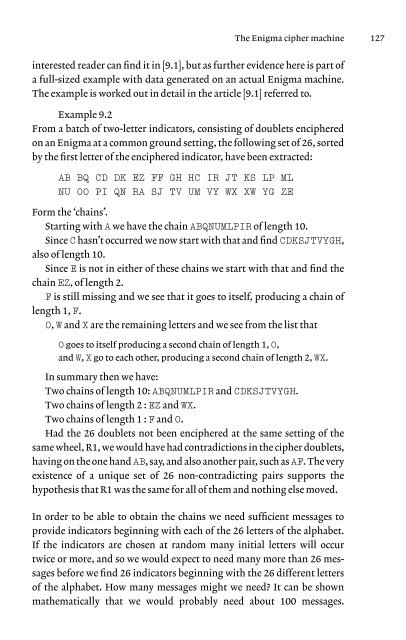Code and ciphers: Julius Caesar, the Enigma and the internet
Code and ciphers: Julius Caesar, the Enigma and the internet
Code and ciphers: Julius Caesar, the Enigma and the internet
You also want an ePaper? Increase the reach of your titles
YUMPU automatically turns print PDFs into web optimized ePapers that Google loves.
interested reader can find it in [9.1], but as fur<strong>the</strong>r evidence here is part of<br />
a full-sized example with data generated on an actual <strong>Enigma</strong> machine.<br />
The example is worked out in detail in <strong>the</strong> article [9.1] referred to.<br />
Example 9.2<br />
From a batch of two-letter indicators, consisting of doublets enciphered<br />
on an <strong>Enigma</strong> at a common ground setting, <strong>the</strong> following set of 26, sorted<br />
by <strong>the</strong> first letter of <strong>the</strong> enciphered indicator, have been extracted:<br />
AB BQ CD DK EZ FF GH HC IR JT KS LP ML<br />
NU OO PI QN RA SJ TV UM VY WX XW YG ZE<br />
The <strong>Enigma</strong> cipher machine 127<br />
Form <strong>the</strong> ‘chains’.<br />
Starting with A we have <strong>the</strong> chain ABQNUMLPIR of length 10.<br />
Since C hasn’t occurred we now start with that <strong>and</strong> find CDKSJTVYGH,<br />
also of length 10.<br />
Since E is not in ei<strong>the</strong>r of <strong>the</strong>se chains we start with that <strong>and</strong> find <strong>the</strong><br />
chain EZ, of length 2.<br />
F is still missing <strong>and</strong> we see that it goes to itself, producing a chain of<br />
length 1, F.<br />
O, W <strong>and</strong> X are <strong>the</strong> remaining letters <strong>and</strong> we see from <strong>the</strong> list that<br />
O goes to itself producing a second chain of length 1, O,<br />
<strong>and</strong> W, X go to each o<strong>the</strong>r, producing a second chain of length 2, WX.<br />
In summary <strong>the</strong>n we have:<br />
Two chains of length 10: ABQNUMLPIR <strong>and</strong> CDKSJTVYGH.<br />
Two chains of length 2 : EZ <strong>and</strong> WX.<br />
Two chains of length 1 : F <strong>and</strong> O.<br />
Had <strong>the</strong> 26 doublets not been enciphered at <strong>the</strong> same setting of <strong>the</strong><br />
same wheel, R1, we would have had contradictions in <strong>the</strong> cipher doublets,<br />
having on <strong>the</strong> one h<strong>and</strong> AB, say, <strong>and</strong> also ano<strong>the</strong>r pair, such as AF. The very<br />
existence of a unique set of 26 non-contradicting pairs supports <strong>the</strong><br />
hypo<strong>the</strong>sis that R1 was <strong>the</strong> same for all of <strong>the</strong>m <strong>and</strong> nothing else moved.<br />
In order to be able to obtain <strong>the</strong> chains we need sufficient messages to<br />
provide indicators beginning with each of <strong>the</strong> 26 letters of <strong>the</strong> alphabet.<br />
If <strong>the</strong> indicators are chosen at r<strong>and</strong>om many initial letters will occur<br />
twice or more, <strong>and</strong> so we would expect to need many more than 26 messages<br />
before we find 26 indicators beginning with <strong>the</strong> 26 different letters<br />
of <strong>the</strong> alphabet. How many messages might we need? It can be shown<br />
ma<strong>the</strong>matically that we would probably need about 100 messages.

















